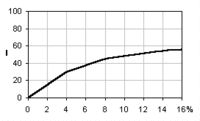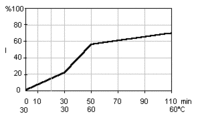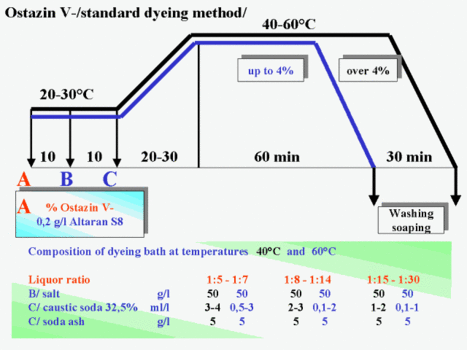Illustration on unmercerized fabric
|
| |
|
|
|
1,50% |
|
4,00% |
| Characteristic |
| C. I. |
Reactive Red 198 |
| C. I. No. |
18221 |
| CAS No. |
78952-61-1 |
| Chemical Class |
Reactive azodye
|
| Properties
|
| Solubility (g/l at 25°C)
| > 100
|
| HT-dyeing of polyester/cotton fibre blends (two-bath dyeing)
| suitable
|
| Pad-Batch dyeing method
| suitable
|
| Levelling power
| good to very good
|
| Washing-off
| very good
|
| Fastness
| cotton
| viscose
|
| standard depth
| 1/25
| 1/12
| 1/6
| 1/3
| 1/1
| 2/1
| 1/25
| 1/12
| 1/6
| 1/3
| 1/1
| 2/1
|
| Light Xenotest
| 3-4
| 3-4
| 4
| 4
| 5
| 5
| 3-4
| 4
| 4
| 4-5
| 5-6BlD
| 5-6BlD
|
| standard depth
| 1/1
| 1/1
|
| Washing 60°C
| 4-5
| 4-5
| 4-5
| 4-5
| 4-5
| 4-5
|
| Washing E2S 95°C
| 4
| 4-5
| 4-5
| 4Bl
| 4
| 4-5
|
| Washing 95°C
| 4Bl
| 4-5
| 4-5
| 4
| 4-5
| 4-5
|
| Perspiration acid
| 4-5
| 4-5
| 4-5
| 4
| 4-5
| 4-5
|
| Perspiration alkaline
| 4-5
| 4-5
| 4-5
| 4-5
| 4-5
| 4-5
|
| Peroxide bleaching
| 4-5
| 4-5
| 4-5
| 4
| 4-5
| 4-5
|
| Rubbing dry
|
| 4
|
|
| 3-4
|
|
| Swimming pool water
| 3-4
|
|
| 3-4Bl
|
|
|
| Hot pressing dry immediately
| 4Bl
|
|
| 4D
|
|
|
| Alkali
| 1-2
|
|
| 1-2
|
|
|
| Mercerizing
| 3Y*
| 4-5
|
| 3-4Y*
| 4-5
|
|
| Acetic acid
| 3-4
| 4
|
| 4
| 4
|
|
| Exhaustion curves
|
| Saturation curve
|
|
|
| Exhaustion curve
|
|
|
| Application possibilities
|
Ostazin V - Exhaustion dyeing 
|
|
|
Ostazin V - Pad Batch 
|
|
|
 suitable suitable  partially suitable partially suitable  unsuitable unsuitable
|
| Testing methods |
| Solubility
| | Evaluated according to
| ISO 105 ZO9
| Ostazin S
| |
| ISO 105 ZO7
| Ostazin V a Ryvalon
| |
|
|
| | The number denotes the maximum dye quantity in grams which is dissolved in the given conditions in one litre of distilled water.
| |
|
|
| | Fastness standards
| | Light Xenotest
| ISO 105-B02-1994
|
| | Washing
| ISO 105-C04-1989
|
| | Domestic and commercial laundering
| ISO 105-C06-1994
| test E2S
| | Perspiration
| ISO 105-E04-1994
|
| | Peroxide bleaching
| ISO 105-N02-1993
|
| | Rubbing
| ISO 105-X12-1993
|
| | Swimming pool water
| ISO 105 E03-1994
|
| | Hot pressing
| ISO 105 X11-1994
|
| | Alkali
| ISO 105 E06-1989
|
| | Mercerizing
| ISO 105-X04-1994
|
| | Acids
| ISO 105 E05-1989
|
| |
| |
|
|
| | The fastness data given in tables denote:
| | for light fastness
| for other fastness data
| | 1 - very poor
| 1 - poor
| | 2 - poor
| 2 - moderate
| | 3 - moderate
| 3 - good
| | 4 - fairly good
| 4 - very good
| | 5 - good
| 5 - excellent
| | 6 - very good
| | 7 - excellent
| | 8 - unsurpassed
| |
|
|
| | The numbers at the individual dye fastness data mean:
| | First number
| - change of shade
| | Second number
| - staining of the undyed adjacent fabric made of the same material as the tested SAMPLE
| | Third number
| - staining of the undyed woolen adjacet fabric
| |
|
|
| | For the fastness to washing at 95°C and fastness to peroxide bleaching the figures have the following meaning:
| | For dyeing of cotton
| | First number
| - change of shade
| | Second number
| - staining of the undyed adjacent cotton fabric
| | Third number
| - staining on the undyed adjacent viscose fabric
| |
|
|
| | u vybarvení na viskóze
| | First number
| - change of shade
| | Second number
| - staining on the undyed adjacent viscose fabric
| | Third number
| - staining of the undyed adjacent cotton fabric
| |
|
|
| | For fastness in mercerizing asterixat the figure means effect to deeper shade
| |
|
|
| | Saturation and exhaustion curves
| | Saturation curves express the dyeing saturation in dependence on the increasing dye concentration in the dyebath. From them it is possible to determine the saturation point of the dyestuff, i.e. the maximum effective dye concentration. On the X axis there are assigned the integrated reflectance I values
| |
|
|
| | Where K/S is the Kubelka-Munk equation
|
|
| | β
| jis surface reflectance
| |
| are the colour matching response functions for the D65 light and 10°standard observer
| |
| | Exhaustion curves were designated from initial concentration of 1/1 standard depth by standard exhaustion method and show the amount of the dye exhausted from the dyebath in dependenc on the dyeing time.
|
|
Detailed product information can also be saved in PDF format



 suitable
suitable  partially suitable
partially suitable  unsuitable
unsuitable




